learn: diamonds > fluorescence
Introduction
Will Prices Keep Falling?
Overview of Fluorescence
Brighter & Whiter
What Changed
Identify Milky, Hazy Fluorescent Diamonds
GIA Over Graded Colour
What Causes Fluorescents?
Big Brands
Yellow Fluoresence Diamonds
The Internet Effect
Blue Fluorescent Diamonds in Sunlight
Fluorescence
Myths & Facts
1. I read online fluorescent diamonds are cheaper: True, but that makes them the best buys. Read on to find why.
2. Lab grown diamonds do not fluoresce: True so it’s the safest way to make sure you have a natural diamond
3. Fluorescent diamonds are hazy and dull:
Wrong. Very few are. Most are brighter and whiter
4. D Flawless fluorescent diamonds are the haziest:
Wrong. Haziness is as likely to occur in a low colour and far less likely in a flawless than an SI diamond

Read on for all the answers
Overview of Fluorescence
You read or hear that strong fluorescent top color and clarity diamonds are sold at a discount so that means they are “not as good” or “to be avoided”. Yet were fluorescent diamonds cost more until 30 years ago because they look whiter and are brighter.
What changed?
- GIA over graded the color of stronger blue fluorescent diamonds (until about the year 2000).
- Discounts started in 1993 when Korean labs and jewelers were caught (fraudulently) over grading the colour of blue fluorescent diamonds. Read on for details.
- Discounting top colour and clarity diamonds is irrational.
- Big brands bad mouth fluorescence (it saves them expert salaries).
- In the past decade “fake information” promoted online has lowered prices even further.
- New GIA research confirms what Garry Holloway has practiced for many years – scattered inclusions interact with fluorescence causing milkiness.

The effect on the colour appearance and grading of blue fluorescent diamonds in different types of lighting have surprising impacts. The additive blue cancels out yellowish or brownish tints that are common in most diamonds. The result is that in better lighting, which is required to detect these subtle shades of colour, blue fluorescent
Fluorescent diamonds generally appear whiter
GIA over-graded colour
Before the 1990’s grading reports or certs were only common for plus one carat, D-E colour flawless to VVS clarity very rare diamonds. This changed in the 1990s when Martin Rapaport launched RapNet®, a dial up internet diamond trading platform and certs became essential for international business-to-business trading.
GIA’s (and most other labs) colour grading setup had too much UV light and grading was done very close to the lamp. Stronger blue fluorescent diamonds were being over-graded by one to three color grades.
Around the year 2000 GIA solved over grading by reducing the UV output of its grading lamps and increasing the distance from the lamps to the diamond reducing the strength of the UV radiation.
GIA now grades in a fair and balanced international commission (CIE) lighting environment.

GIAs new grading lamps were upgraded to meet CIE ID50, ID65, D55 and D65 so that the amount of UV radiation emitted has been significantly reduced.
Left: Before 2000 GIA colour grading lamps emitted a lot of UV. Grading was done too close to the light.
Right: Since Today GIA uses low UV lamps and grade diamonds from further away at a pre-set distance.
The Korean Blues
Rapaport Diamond Report magazine published this story in June 1993 after SBA-TV, South Korea, broadcast We Want to Know That (May 9, 1993)
Korean retailers and consumers loved blue fluorescent diamonds. However, the Korean current affairs TV program in 1993 accused local Korean labs of over-grading the color of fluorescent diamonds: “your D is really E”. Korean traders replaced many of the fluorescent diamonds with non fluorescent stones and dumped the fluorescent diamonds back into global markets.
This led the Rapaport Diamond Report business price list to discount larger top color and clarity blue fluorescent diamonds that the wealthy Korean industrialists had replaced. This became a self-fulfilling prophecy and is still in place today. For all the wrong reasons.
The joke is, that fluorescent diamonds continue to be even more deeply discounted based on events that occurred thirty years ago!
Rapaport discounts almost disappeared a few years after the Korean stones all cleared out. But since then the Internet became a source of “education” and consumers learned fluorescent diamonds are bad because they are cheaper. This chart show that the discounts have grown.
My diamond book is going to reverse this process and make strong blue fluorescent diamonds more valuable, as they should be
Highlights Of Rapaport Fluorescence Discount “Adjustments” for Strong DE VS
A year after the first listing in 1993, Rapaport reduced the discount from 5-7% to 3-5%. In April 2015, F was added to the top colors D and E, and the discount then increased from 3-5% to 10-15%. January 2020 carat weight ranges were added and the Very Strong fluorescence notation was dropped. In May 2023, 1ct D-F VS is now -26%. As a result, you can buy a better looking diamond for less!
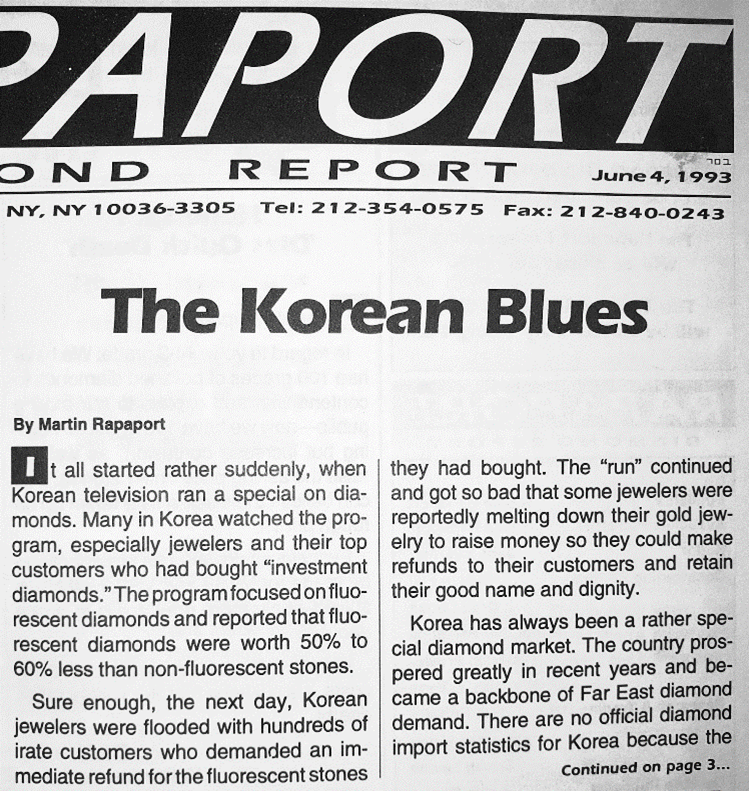
Raport Article June 4th 1993
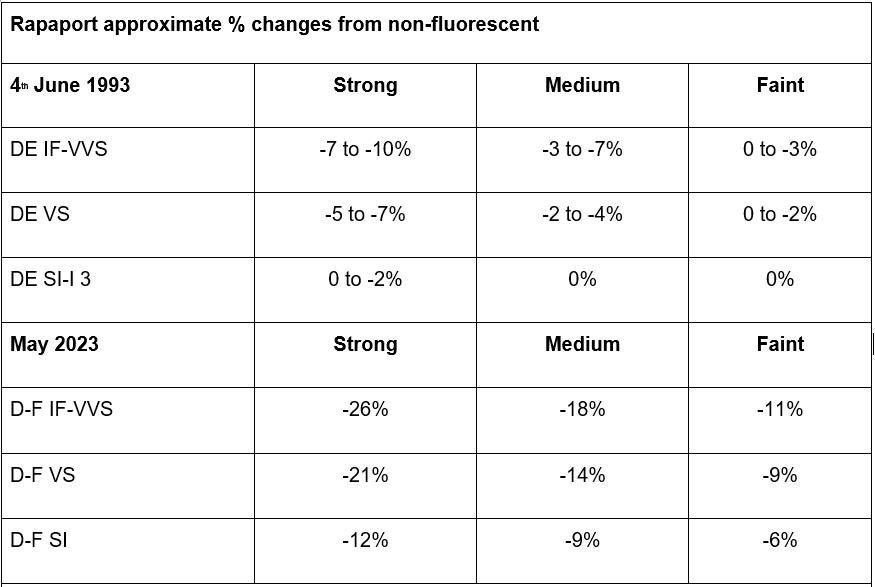
Fluorescent discounts started because in 1993 Korean stones were dumped on the market. Discounts were reduced in the years after. Then the Internet and brands “fear factor” kicked in and discounts illogically increased by multiples.
Why Do Top Colour and Clarity Get Big Discounts?
These next two tables (made at different times) show the stupidity of the discount structure being applied to top clarity and colour diamonds. The only valid reason is the super-rich people in unstable or autocratic countries use diamonds as a store of wealth or running away money. They can flip a GIA certified D Flawless diamond by emailing or sending the cert via Whats App to find a buyer if the government or criminals come after them!

There were 50 Strong and Very Strong fluorescent Flawless to SI1 diamonds described by the vendors as ‘Milky’ listed on RapNet® on 22nd September 2021. There are 3 to 4 times as many diamonds listed on RapNet from D to G than J to S, so there is no link between milkiness and colour. Naturally, there were many more lower-clarity milky diamonds, the opposite of the market pricing.

A total of 50 vendor vendor-described ‘Milky’ Strong & Very Strong fluorescent diamonds were listed on RapNet® on 19th August 2022 (compared to more than 16,000 non fluorescent milky diamonds).
60% of the 50 Strong and Very Strong fluorescent Flawless to SI1 diamonds described by sellers as being milky were SI1. Only 1 was in the Flawless to VVS range. That’s the opposite of market pricing: top clarity diamonds are discounted by almost twice that of SI1 diamonds. High color diamonds had no relationship with milkiness.
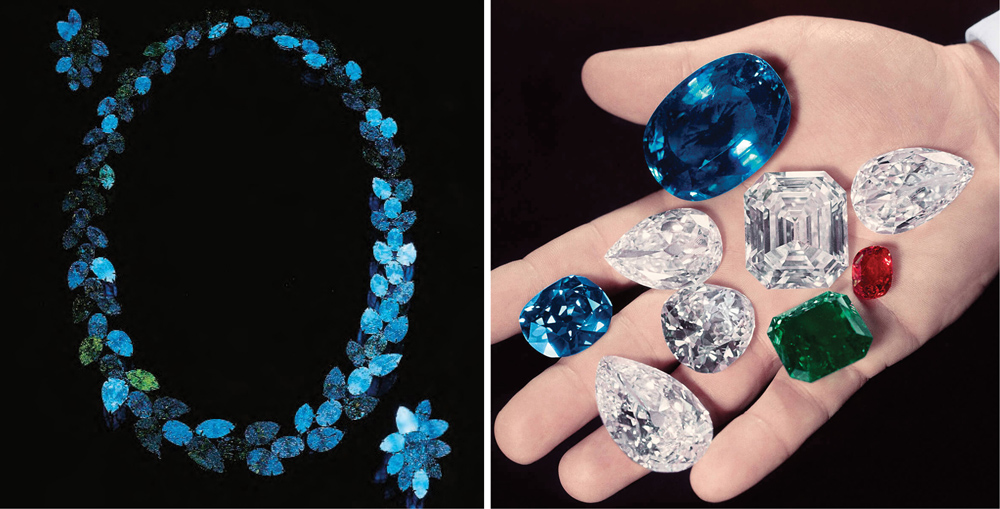
Right: part of the ‘Court of Jewels’ that Harry exhibited on a world tour included two of the worlds most famous diamonds. The Hope (the smaller blue diamond) and the Portuguese (the emerald cut). Both are on exhibition at the Smithsonian in Washington DC. Both have unusual fluorescence. Courtesy: Harrywinston.com
Big Brands Effect
Big jewellery brands train salespeople to tell consumers to avoid strong fluorescent diamonds. Why? Every fluorescent diamond must be checked by an expert gemmologist for transparency. It costs money to train salespeople how to sell fluorescent diamonds.
Harry Winston, the King of Diamonds, was an internationally acknowledged diamond expert. My friend David Friedlander is a New York diamond seller who trained as a grader at Harry Winston. I asked him: Did Harry have a process to screen out milky hazy stones?
“Winston had a category called “Premier” which were Medium to Strong blue D-E colors that looked “super white”…they sold at a premium. All screening was done by old timers- or Winston trained graders. It’s quite easy to screen hazy stones under “normal” diamond viewing conditions- natural light and fluorescent tubes”.
The Internet Effect
There’s a direct correlation between deepening discounts and the rise of internet information, or more correctly, misinformation. The greater the price difference the more this becomes a self-fulfilling prophecy. ‘Cheaper can’t be better?’ Fluorescence is a savvy collectors greatest opportunity.
Fake news about fluorescence from the Internet, November 2021:
Colorless diamonds, those with a color grade of D-F, are sold at a discount if they have a fluorescent glow underneath a UV light. This is because the fluorescence is seen as a flaw, so the diamond no longer holds the same value. Some people believe that fluorescence causes D-F colored diamonds to look slightly oily or hazy, which is not a desirable quality. www.brilliance.com
Strong or Very Strong Blue Fluorescence: These diamonds usually appear hazy or cloudy.
Medium Blue Fluorescence with a high Color grade (G or better): These diamonds also usually appear milky or hazy.
Diamonds in the colorless range (D-F) don’t benefit from fluorescence. They’re actually considered less valuable, so their price and desirability are also lower. www.diamonds.pro
You’ve probably read that fluorescence can give diamonds a color boost. That’s not true at all. While you’re unlikely to notice any difference, diamond fluorescence can actually make the diamond appear worse under most lighting conditions. Cloudiness is more common in higher color grades, so it’s best to avoid strong and medium fluorescent diamonds in D, E, and F color diamonds. In G and H color diamonds, milkiness is less common and fluorescence can offer a significant discount. www.gemsociety.org
In almost every diamond I’ve seen, diamonds with strong blue fluorescence looked hazy, so whether you’re going with a colorless diamond or even higher colors, you better avoid this level. As fluorescence gets stronger there tends to be a haziness in the diamond that affects its brilliance. So a diamond with strong blue fluorescence will not seem as clear as the same diamond with light or no fluorescence. www.selectingadiamond.com
Internet sellers, and affiliates who recommend online vendors for a commission, all have a vested interest in reducing costly returns.
The online consumer takes a diamond to a high street jeweller: “What, you bought a fluorescent diamond!” Internet vendor gets a returned diamond and can’t return the drop shipped stone for a refund. Owning inventory is not their business model. Affiliates must repay commissions. They both say “Don’t buy fluorescent diamonds”.
Will prices keep falling?
Who knows? But there are two important recent developments that could reverse the trend.
Firstly, in September 2021 GIA published a study led by a GIA researcher Dr. Yun Luo.
She discovered my secret that scattered very small clouds of inclusions and growth lines combined with fluorescence cause haziness. Dr. Yun Luo and co-authors confirmed that strongly blue fluorescent diamonds are brighter and whiter in some lighting. The Luo study found a slight reduction in contrast in colourless and darker parts of the diamond caused by the addition of a blue tint. This is more than made up by additional brightness and beautiful blue whiteness.
Dr. Yun Lou’s system can be used to grade transparency. I asked her will GIA do it and her reply was: “I hope so”.
Secondly, there is a “rumbling of discontent” from diamond miners who don’t want up to a third of their most valuable diamond rough discounted!
Customers ask: “Why shouldn’t I just buy a non fluorescent diamond?” The answer is simple, well selected fluorescent diamonds cost less and look better.
I am a fan of fluorescent diamonds and have sold many over 46 years of retailing. Many millions of dollars worth. I consider the diamonds I have sold are still my diamonds since I offer my clients an upgrade deal on any diamond I have previously sold. Clients receive full credit for what they paid for the diamond toward a more expensive diamond. Common sense and the findings from further research will one day flip opinions on fluorescence and all those trade-up diamonds will be more valuable. But simply put, like diamontaires before Koreagate, I prefer fluorescent diamonds.
Garry Holloway
Brighter and Whiter
In the image on the right, the E and I strong to very strong blue fluorescent GIA graded diamonds show the effects of on the diamonds of light devoid of UV light and the type of light used by GIA and finally in shaded daylight equivalent.
The numbers below each image represent luminosity and colour with 255 being the maximum for red, blue, green and the total of white that is used in computer colour space. Using Paint in Microsoft software points were assessed from each image. The larger top row numbers represent a spot measurement from the whitest and brightest parts of each image, and the smaller numbers were taken from the darkest parts of the star patterns. (Red and green values were consistent and ignored). Higher luminosity values indicate brighter images and the white parts of the E diamond were 2.35% brighter and the I diamond was 0.8% brighter in the right side images that have more UV in the lighting. The increase in brightness is because of the addition of blue light radiated. Adding the blue creates a more desirable coloured diamond.
A quote from Dr. Yun Luo led GIA paper linked above:
“…we see that the fluorescence makes the stone brighter; however, because the dark areas are less dark and the light areas gain a blue hue from the fluorescence, contrast is reduced.”


Milky Hazy Fluorescent Diamonds
It’s a real problem because labs do not grade transparency or describe a diamond in lay terms like hazy, milky, or with reduced sparkle. Fluorescent diamonds only become hazy when seen in a UV or a lighting environment with visible violet; natural shaded daylight is perfect, even if the light is coming through a window, but labs grade diamonds in dim darkened rooms and can rarely see the milky effect.
How Do Holloway Avoid Hazy Fluorescent Diamonds
We reject diamonds with Internal Graining and Clouds. GIA misses most internal graining, but we have proprietary tricks. Next, we hold the diamond being tested in tweezers less than 25mm from a white fluorescent tube that emits an excessive amount of UV. The diamond on the left in the image below is hazy and milky.
For online shoppers, those videos and photos are made in light that has little or no UV so you can’t tell if the stone will be hazy or milky.
If you’re examining a diamond inside a store that only has LED lights and no daylight coming through windows, it’s quite possible that the stone’s haziness will go undetected. Both Holloway Diamonds stores have north-facing windows and lots of daylight.
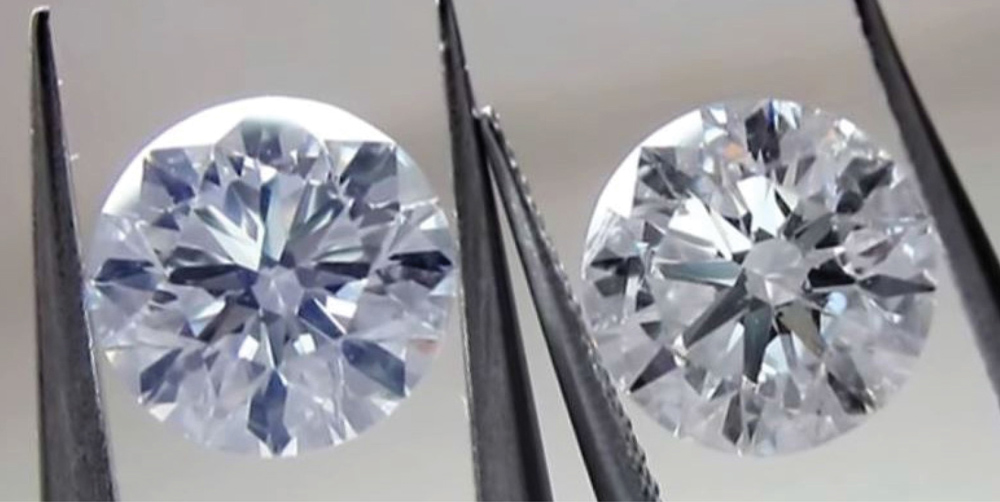
The diamond on the left is hazy because it has scattered inclusions that when combined with fluorescence cause the diamond to appear milky and hazy in any light that has uv like shaded daylight. Both diamonds are strongly fluorescent. Holloway diamonds™ are all screened for maximum transparency.
The US Banned Blue White Diamonds
The US is where the term ‘blue white’ or whiter than white for top colours D,E and F was coined for blue fluorescent diamonds more than a century ago. But smart marketers passed off much lower-colored diamonds as ‘blue white’ to achieve a higher price. The United States of America Federal Trade Commission (FTC) took note and curbed the practice, effectively banning the use of the term ‘blue white’.
March 18, 1938 with the following resolution 23.14, (Trade Practice Rules for the Wholesale Jewelry Industry, Rule No. 6, p4: 23.14 Misuse of the term “blue white.” 2 , 3 It is unfair or deceptive to use the term “blue white” or any representation of similar meaning to describe any diamond that under normal, north daylight or its equivalent shows any color or any trace of any color other than blue or bluish.
The ban on the use of the term “blue white” by the FTC resulted in a change in retail marketing practices, but did not change the practices of high end jewellers like Mr. Harry Winston. To this day; however, many older jewellers and their families continue to seek out high colored blue fluorescent diamonds for their personal use.
What causes Fluorescence?
Tiny traces of nitrogen are present in all diamonds that are classified as Type I (Type II diamonds have no nitrogen and make up less than 3% of all natural diamonds. Synthetic or lab grown diamonds are Type II, so buying a fluorescent diamond is a simple way to be sure not to get ripped off with a synthetic or lab grown diamond). When present in the right arrangement in the atomic lattice, long wave UV and visible violet light cause electrons in the inner shells of nitrogen atoms to momentarily jump to the outer shells. As they drop back they emit energy in the form of the powder-blue colored light that we see in the dark when a diamond fluoresces blue.
When diamond crystals grew and formed hundreds of miles down, any nitrogen present in the crystal lattice structure tended to be distributed throughout the stone. Over time, while still under immense heat and pressure, nitrogen atoms tend to migrate and gather together in groups of three sharing one of their five outer shell electrons with adjacent carbon atom four outer shell electrons. We call these clusters N3. Scientists call this blue fluorescence, present in about 30% of all diamonds, N3 fluorescence.
The simplest test to identify lab grown diamond jewelry that is set with a large quantity of diamonds is to shine a cheap UV torch and see how many diamonds fluoresce. If none do, the piece is likely set with synthetic diamonds. If about a third fluoresce that is a good indication the piece is set with natural diamonds.
If a UV light is shone on fluorescent diamonds in the dark and the UV light is turned off, some diamonds will continue to glow or phosphoresce for a few seconds to minutes. Interestingly most synthetic or lab grown diamonds phosphorescence yellow or green. This is one of the simple identification tests our gemmologists use at Holloway Diamonds, especially for smaller sizes and set diamonds. We can check hundreds of diamonds at a glance with the Gemetrix synthetic diamond tester.
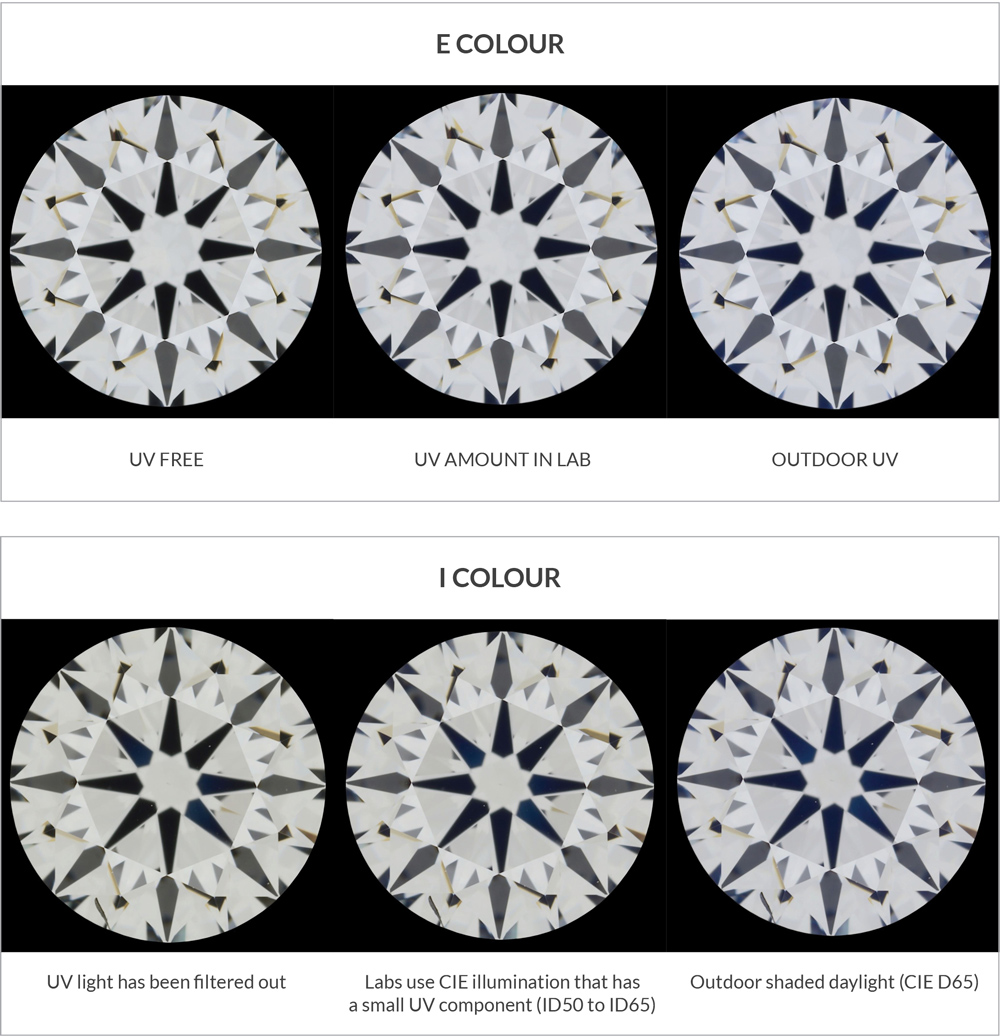
Yellow and Other Color Fluorescence
More than 90% of fluorescent colorless diamonds exhibit blue fluorescence. Yellow is the next most common. Orange, green and red are very rare in colorless diamonds but all other than blue colors are more common in fancy colored diamonds. Very strong fluorescence is rare in other colors than blue.
Yellow fluorescence should definitely be avoided in colorless diamonds because the stone becomes yellower when seen in UV rich lighting lowering the apparent color and value. A discount is appropriate. Yellow and orange fluorescence benefits Fancy Yellow diamonds.
Blue Fluorescence and Diamonds in Sunlight
People think they can see blue fluorescence in direct sunlight. It’s more likely they are seeing blue from the sky. Please go here to read all about the sunlight effect:
www.hollowaydiamonds.com.au/blue-fluorescence-diamond-in-sunlight/

Scan the QR code to view the blog – Blue fluorescence diamond in sunlight.
